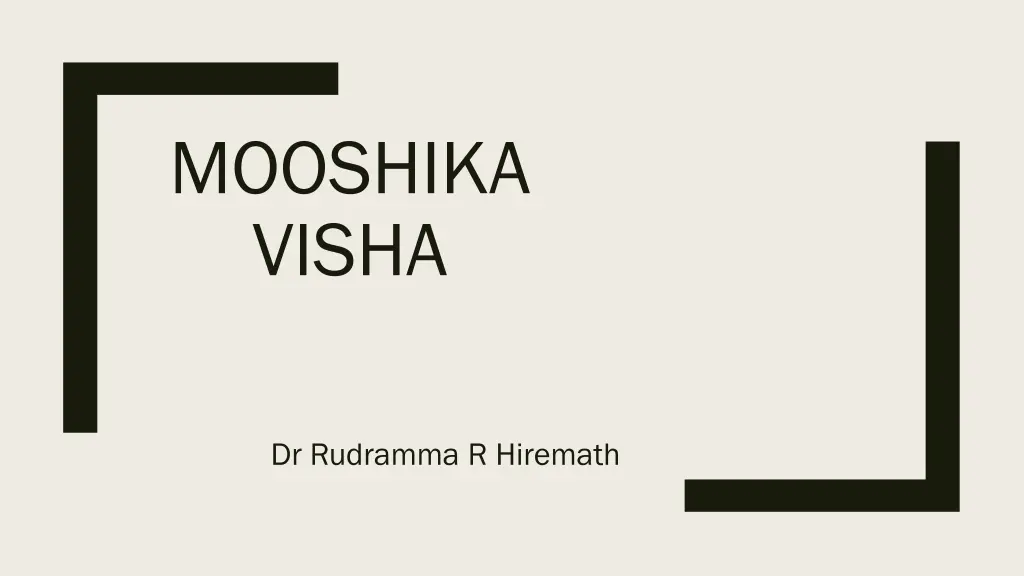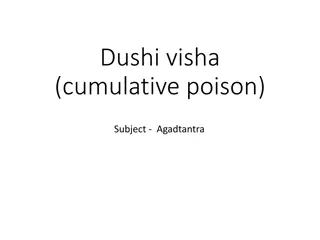
Understanding Mooshika Visha and Its Treatment Methods
Explore the ancient concept of Mooshika Visha in Ayurveda, its modes of transmission, symptoms, influencing factors, and treatment methods as described in traditional texts. Learn about the potential complications, preventive measures, and the role of Ayurvedic remedies in managing Mooshika Visha.
Download Presentation

Please find below an Image/Link to download the presentation.
The content on the website is provided AS IS for your information and personal use only. It may not be sold, licensed, or shared on other websites without obtaining consent from the author. If you encounter any issues during the download, it is possible that the publisher has removed the file from their server.
You are allowed to download the files provided on this website for personal or commercial use, subject to the condition that they are used lawfully. All files are the property of their respective owners.
The content on the website is provided AS IS for your information and personal use only. It may not be sold, licensed, or shared on other websites without obtaining consent from the author.
E N D
Presentation Transcript
MOOSHIKA VISHA Dr Rudramma R Hiremath
Introduction to MOOSHIKA VISHA Jangama Visha/ ShukraVisha References : Su K 7thch.(Mushika kalpam) ASU 46thCh. (Mushikalarka Pratishedham) AHU 38thch.(Mushikalarka visha pratishedha) Vyavayi, kasta saadya and aggravats oftenly Influencing Factors: Rainy, cloudy, when doshas get increased
Modes of Transmission Ref: Prayogasamuchayam: four modes of transmission 1. contact of the semen of rats 2. contact of a substance contaminated with rat s semen 3. rat bite 4. scratches by nails.
Mooshika Visha Lakshana - . . / -
Mooshika Visha Lakshana - . . . / -
Treatment (A.S.U 46) 1. Cauterization (A.S.U 46/18) 7. Nasal Medication (A.S.U 46/29) 2. Blood Letting (A.S.U 46/19) 8. Collyrium (A.S.U 46/30) 3. Application of paste (A.S.U 46/20) 9. Consumption of medicated ghee (A.S.U 46/31) 4. Washing and application of paste (A.S.U 46/21) 10. Special yogas (A.S.U 46/36) (Decoction of Sindhuvara+natam+shigru+bilwamoola+punarnawa+shwadam- shtra+jimutaka with honey) 5. Emesis (A.S.U 46/22) 11. Removal of rings (A.S.U 46/41) 6. Purgation (A.S.U 46/29)
Virudh ahara vihara-desha-anna-kala Potency of dooshi-visha increases anupdesha Poorvi-vayu Cold,cloudy wheather Incompatible food Mooshika visha Aavarna by kapha It vitiates the body elements(dhatus) Kapha and vata doshas increases Pitta and vata doshas increases
Leptospirosis LEPTO(Thin) + SPRIA (coil) which means a tiny spiral bacteria Gram negative Dark microscope with immunofluorescence Aeobic bacteria Genus of spiral bacteriaa cause zoonotic infection. 20 Species,most common is Leptospira interrogans Weil s Syndrome, Swamp Fever, Mud Fever, Swineherd s Disease, Rice-Field Fever, Cane-Cutter s Fever, Hemorrhagic Jaundice, Canicola Fever First described by Weil in 1886 in Germany. May progress to kidney or liver failure, aseptic meningitis, life-threatening pulmonary hemorrhage.
Mode of transmission Leptospirosis is transmitted by the urine of an infected animal and is contagious as long as it is still moist. Although rats, mice, and moles are important primary hosts, a wide range of other mammals including dogs, deer, rabbits, hedgehogs, cows, sheep, raccoons, opossums, skunks, and certain marine mammals are able to carry and transmit the disease as secondary hosts. Dogs may lick the urine of an infected animal off the grass or soil or drink from an infected puddle. Leptospirosis is also transmitted by the semen of infected animals. Humans become infected through contact with water, food, or soil containing urine from these infected animals. This may happen by swallowing contaminated food or water or through skin contact
Causes Various species of Leptospira, a spirochete in the family Leptospiraceae, order Spirochaetales Serovar- basic unit of leptospira taxonomy 250 pathogenic serovars, and 50 nonpathogenic serovars L. interrogans, L. borgpetersenii. L. alexanderi, L. alstonii, L. inadai, L. fainei, L. kirschneri, L. licerasiae, L. noguchi, L. santarosai, L. terpstrae, L. weilii and L. wolffii.
Risk factors include: Occupational exposure farmers, slaughterhouse workers, trappers, veterinarians, sewer workers, rice field workers, and military personnel Recreational activities fresh water swimming, canoeing, kayaking etc. Household exposure pet dogs, domesticated livestock, rainwater catchment systems, and infected rodents Environmental exposure Floods etc.
Physical examination fever with conjunctival suffusion, muscle tenderness, lymphadenopathy, hepatomegaly, splenomegaly. The rash may be macular, maculopapular, erythematous, urticarial, or hemorrhagic. Mild jaundice may be present.
Diagnosis On infection themicroorganismcan be found inbloodand CSF for the first 7 to 10 days (invoking serologically identifiable reactions) and then moving to the kidneys. After 7 to 10 days the microorganism can be found in fresh urine. Hence, early diagnostic efforts include testing a serum or blood sample serologically with a panel of different strains. Detection of organism in blood, cerebrospinal fluid, urine or tissue samples Staining with immunogold-silver Dark field microscopy MAT (micro agglutination test) ELISA Culture is definitive but takes 13 to 26 weeks
Sign and Symptoms Acute or septicemic phase -nonspecific signs -fever, chills, headache, myalgia (back, thighs) -weakness, abdominal pain, nausea, photophobia -usually lasts several days to approximately a week -many patients recover in this phase Immune phase -anti-Leptospira antibodies develop at this phase. -either anicteric or icteric disease manifests -severe headache, stiff neck and other meningeal symptoms -icteric is severe with multi-organ failure involving liver, kidney, CNS -in < 5% patients, pulmonary form of leptospirosis is seen; appears on 4th /6th day usually and with pulmonary hemorrhage and edema, with dyspnea and hemoptysis
Anicteric Leptospirosis fever, chills, severe headache, nausea, vomiting, and myalgias. Muscle pain,
Severe/icteric Leptospirosis (Weil's Syndrome) pericarditis, congestive heart failure, jaundice, cardiogenic shock, renal dysfunction, adult respiratory distress syndrome, and hemorrhagic diathesis necrotizing pancreatitis, Rhabdomyolysis, hemolysis, myocarditis, Hepatomegaly splenomegaly
Treatment and Chemoprophylaxis of Leptospirosis Regimen Purpose of Drug Administration Treatment Mild leptospirosis Doxycycline, 100 mg orally bid or Ampicillin, 500 750 mg orally qid or Amoxicillin, 500 mg orally qid Penicillin G, 1.5 million units IV qid or Ampicillin, 1 g IV qid or Amoxicillin, 1 g IV qid or Ceftriaxone, 1 g IV once daily or Cefotaxime, 1 g IV qid or Erythromycin, 500 mg IV qid Doxycycline, 200 mg orally once a week Moderate/severe leptospirosis Chemoprophylaxis
References A.S.U 46 A.H.U 38 SU.K. 7 Wang S,Stobart Gallagher MA,Dunn. Leptospirosis (Weil disease) [updated 2019 oct 25].In StatPearls [internet].Treasure island(FL): StatPearls Publishing;2020 jan.






















